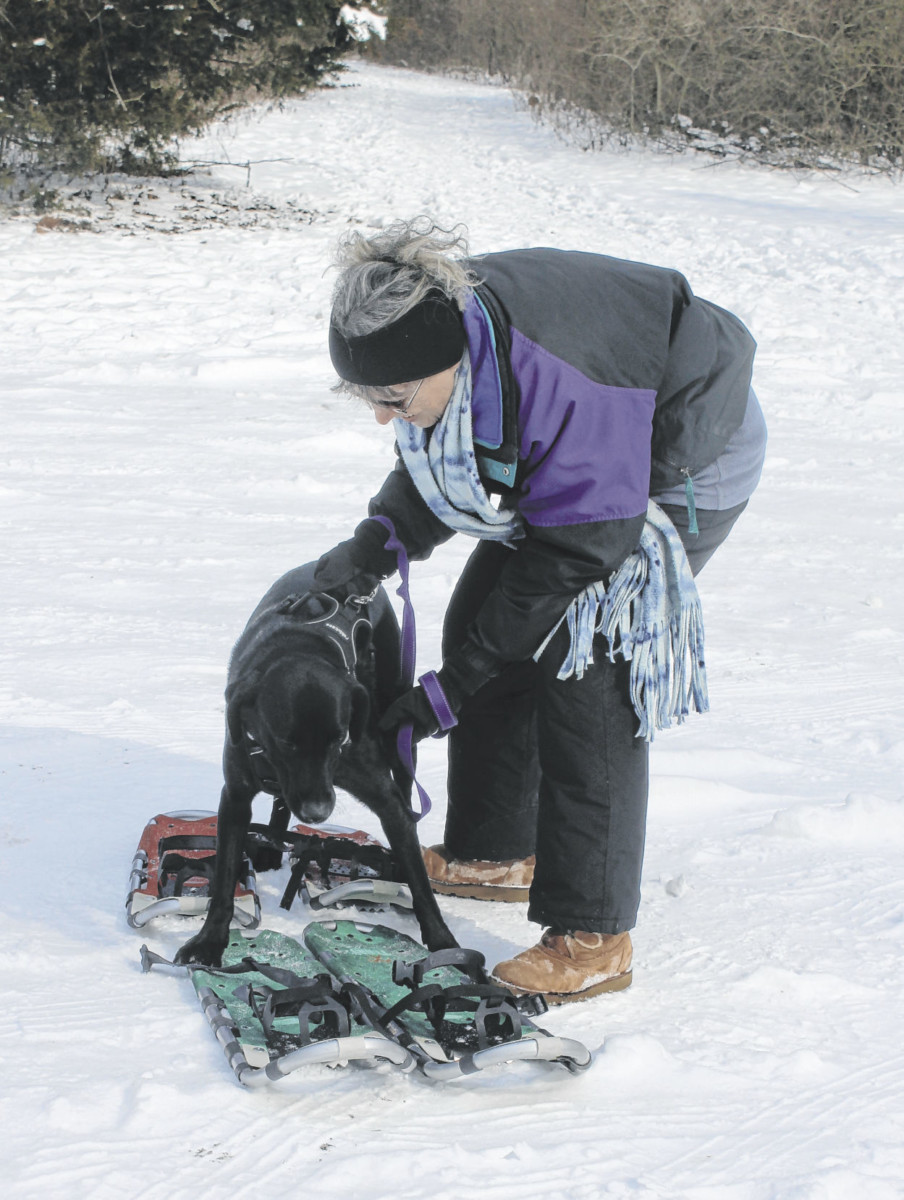
Given that the first snowshoes date to about 6,000 years ago and it is believed when the first people hiked across the Bering Land Bridge to North America they were wearing them, those of us on the Freedman Family Snowshoe Outing were following in the footsteps of humanity.
I wasn’t present for that historical Siberian trek, so I take historians’ word for it, and I also take for granted that when the “shoeski” guys were faced with a dilemma of eight feet and four snowshoes, they let the dog walk.
Despite our good intentions of providing Boston’s first snowshoeing lesson, my wife, Debra, and I strapped on the available aids and counted on his four-footed balance to be sufficient as we clomped along the Hunt-Richart Lake Trail in Muscatatuck National Wildlife Refuge east of Seymour.
Some people use poles for balance like cross-country skiers, but we were bold adventurers and skipped that accessory.
It was late morning Sunday. The sky was turning from overcast to slightly sunny, the temperature climbing from 10ish to 20ish and the wind dying to a puff of a breeze. This all made for pleasant outdoor accommodation unless you are the type of person who shivers when opening the refrigerator.

[email protected]
Snowshoeing is the most benign of outdoor winter recreation. Moving by human power, you control the speed, unlike downhill skiing, which is a car wreck waiting to happen, ski jumping, which is available in about three places across the whole United States, ice fishing, which perhaps 90% of anglers choose to avoid, or Nordic skiing, bobsled or luge, ignored by Americans for all but two weeks during a Winter Olympics cycle.
Snowshoeing is walking with thingamajigs strapped to your feet so you don’t sink up to your kazoo in drifts.
I’m not exactly sure who took notes on the Land Bridge folks coming to America on snowshoes, but they were invented for transportation, not sport.
Images of mountain men or trappers often show them in wilderness with feet strapped into feet-long snowshoes resembling elongated tennis racquets. They were made of wood, and the bindings were rawhide. The so-called Yukon-style snowshoes might be 46 inches long.
This equipment enables you to walk on top of the snow. It was man’s response to nature throwing up roadblocks of soft texture snow. The purpose was very utilitarian, of great assistance for overland travel through the woods or for the hunter needing food.
There is no instructional manual, only common sense, but one’s first inclination is to walk on snowshoes as one does on flat land. Those movie scenes or paintings of grizzled outdoorsmen (who undoubtedly obtained all their Boy Scout merit badges) never depict a guy flat on his face licking snow off his beard after he tangled up the long shoes and fell. So be warned that a slight side-to-side stepping motion is wise.
For most of those thousands of years of snowshoe manufacture, personally made or otherwise, no one considered snowshoeing for just plain exercise, fun or sport. Eventually, as an outgrowth of the running boom, snowshoeing was adopted as a method of play.
However, it turns out those snowshoes nearly as long as surfboards were not for fast movement, and more advanced aluminum framed snowshoes that were somewhat rounder found their way to market in the 1970s.
In the late 1980s, I was in Whitehorse in the Yukon Territory for an Olympic-style festival of the North called the Arctic Winter Games and included was snowshoe racing. The shoes were smaller, and the course was a smoothed snow trail.
When the race ended, I borrowed a pair to try. Stepping off 0f the trail, I immediately sunk and fell over. These shoes did not glide atop the drifts but basically accommodated running snowshoers.
Eventually, I purchased the best snowshoes for us — aluminum frames, plastic bindings that were adjustable and could be strapped on tightly enough to avoid yanking a boot-clad foot right out.
When it comes to racing, there is a U.S. championships overseen by the United States Snowshoe Association. Last year, it was in Leadville, Colorado.
Muscatatuck Park Ranger Donna Stanley informed me few people snowshoe in the refuge, though she said she tried it about a decade ago. Few people at all frolicked in the snow there Sunday. We passed a half-dozen cars and about the same number of ducks. Neither species were on snowshoes.
Nor was Boston. The trail was layered with a few inches of fresh snow, but it wasn’t deep, so we could shuffle along comfortably. Being a dog, Boston was most intrigued with never-before-seen trees and bushes. Not sure whether he hoped to scare off tigers, find a new romantic interest or what. During our hike of a mile-plus, Boston marked more territory than Christopher Columbus.
This black Labrador retriever was 60 pounds of sleek muscle and a ton of curiosity, and he nearly pulled me over several times with his enthusiasm.
My wife doesn’t mind the occasional cold-weather exercise, but her viewpoint on freshly fallen snow on the back steps, path and driveway seems roughly equivalent to her attitude towards dust on furniture — it is there to be brushed away.
Romantic that I am, I gushed that there we were in the solitude of the backcountry snows with the only sounds of the occasional bird call.
“Backcountry?” Debra snorted. “Maybe the outskirts of town.”
Just because we were only about two miles from a McDonald’s.
